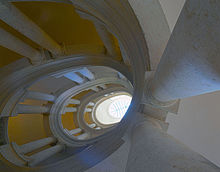Palazzo Barberini
The Palazzo Barberini is a palace in Rome . It houses part of the important art museum Galleria Nazionale d'Arte Antica (National Gallery of Ancient Art) and the Istituto Italiano di Numismatica (Italian Institute for Numismatics ).
The palazzo is located on the northern slope of the Quirinal hill about 50 m southeast of the Piazza Barberini . Access is on Via Quattro Fontane .
architecture
The palace was built in the years 1627–1638 in the Baroque style. The clients were the two nephews of Pope Urban VIII , Taddeo Barberini , the prince of Palestrina , and his brother, the cardinal depot Francesco Barberini . Carlo Maderno first worked as an architect , after his death in 1629 Gian Lorenzo Bernini took over the construction management. Francesco Borromini was also involved in the work . a. designed the spiral staircase in the south wing.
The north wing rests on ancient substructures and contains the remains of a villa of the Sforza family , whose coats of arms can still be seen in the frescoes in the rooms. The prince's family moved into this wing, the north facade of which faces Piazza Barberini, in 1632. The newly built south wing contained the cardinal's apartment and famous library. In the middle wing of the palace, which the two parties shared, are the Salone grande and a smaller oval hall. The splendid, seven-axis main facade is divided into three floors by a Doric, Ionic and Corinthian column arrangement , based on the model of the Colosseum . The fact that the central wing is set back from the wings creates a courtyard of honor, which is atypical for Roman palaces and can be compared with French city palaces. The loggia on the ground floor provides access to the two stairwells. A theater (1636–1637) and the garden complete the complex.
The great room contains a major work by the painter Pietro da Cortona , the monumental ceiling fresco with the "Allegory of Divine Providence". He created it in the years 1633–1639. The altarpiece and the frescoes in the palace chapel also come from him . Andrea Sacchi (fresco with the Allegory of Divine Wisdom) and Giovanni Francesco Romanelli were also involved in the decoration of the other rooms .
In 1953 the building was opened to the public. In 1949 the palace became state property. Since July 2011, the Palazzo Barberini with all its rooms has been completely accessible to visitors again after 60 years of renovation.
collection
The basis form works that after the dissolution of the Papal States in 1870 in the possession of the Italian State reached. The collection now houses over 1500 works from the 12th century to neoclassicism , etc. a. Works by:
- Filippo Lippi : Madonna and Child (Madonna col Bambino) from 1437
- Raphael : La Fornarina (1520)
- Jacopo Tintoretto : Christ and the adulteress (Cristo e l'Adultera) from the years 1546–1548
- El Greco : Adorazione dei Pastori e Battesimo di Cristo from the years 1546–1548
- Hans Holbein the Younger : Portrait of King Henry VIII from 1540
- Michelangelo Merisi da Caravaggio : Narcissus (Narciso) from the years 1598–1599
- Michelangelo Merisi da Caravaggio: Judith and Holofernes (Giuditta che taglia la testa a Oloferne) 1597/1600
literature
- Heinz-Joachim Fischer : Rome. Two and a half millennia of history, art and culture of the Eternal City. DuMont, Cologne 2001, ISBN 3-7701-5607-2 , pp. 278-280.
- Anton Henze, Kunibert Bering, Gerhard Wiedmann: Art guide Rome. 5th, revised edition. Philipp Reclam, Stuttgart 1994, ISBN 3-15-010402-5 , pp. 285-286, 315-316.
- Patricia Waddy: Palazzo Barberini alle Quattro Fontane . In: Christina Strunck (Ed.): Rom. Masterpieces of architecture from antiquity to today. Festgabe for Elisabeth Kieven (= studies on international architecture and art history. Vol. 43). Michael Imhof, Petersberg 2007, ISBN 978-3-86568-186-7 , pp. 350-355.
Web links
- Official website of the museum (Italian)
- "Galleria Nazionale d'Arte Antica a Palazzo Barberini"
- National Gallery of Ancient Art in Palazzo Barberini (en.)
- Piazza Barberini, Palazzo Barberini (en.)
Individual evidence
Coordinates: 41 ° 54 ′ 12.7 " N , 12 ° 29 ′ 24.7" E





